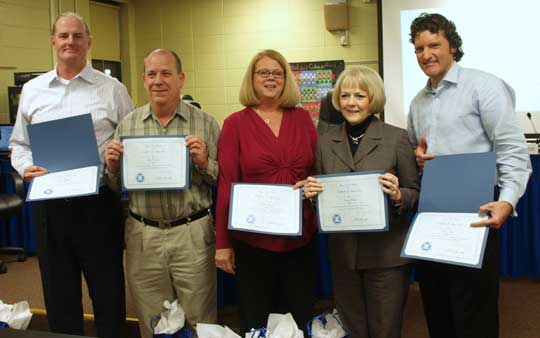 By Lana Clifton
By Lana Clifton
At its first session of the new year, held Monday, Jan. 18, the Bryant School Board approved a 10-year facility plan that included a phase approach for accommodating current and predicted future growth in the student population.
Phase 1 of the plan would involve adding classroom space to Springhill Elementary and classrooms, cafeteria space and a full service kitchen at Salem Elementary. The work at Salem would also include improvements to bathrooms and the sewer system and connecting the two existing buildings so all classrooms would be under one roof.
Phase 2 would begin with an application for state partnership funding to build a new elementary school to accommodate 625 students. The estimate on the report said the project would require a minimum of 15 acres. This building would also allow for the future proposed ninth grade academy.[more]
Since the plan was approved, it will be reviewed by the state and legislative review in the spring of 2011 allowing design work on phases 1 and 2 to be completed in the summer of 2012 with construction to be completed by January of 2014.
Phase 3 would require the district to apply for funds to construct a second elementary school in January 2012. The second school would allow BES to be moved off the current campus and for ninth grade to move off the high school campus. Under this plan, the second new elementary would not open until January of 2016.
In a statement to the board prepared by Superintendent Dr. Richard Abernathy it said, “By completing Phases 1, 2, and 3, Bryant should be on top of the facility program to handle the projected enrollment.” He continued by reminding the board that, as population in different areas of the district changed, grade configurations and attendance zones would need to change and portable buildings would need to be utilized during the changes.
The board must approve a 10-year plan every year prior to Feb. 1. It is described as a fluid document in which changes can be made as different needs arise.
A guest was also on the agenda to address the board. Dr. David Jolliffe of the University of Arkansas at Fayetteville presented the findings of a study on the district’s high school literacy program.
Jolliffe, the Brown Chair in English Literacy at UA, led a team contracted by the district to examine the high school English department including the curriculum pacing guide, school data for grades 9-12, teachers’ lesson plans and student writing samples. The other members of the team were Dr. Sandra Stotsky, Endowed Chair in Teacher Quality; Dee Schulten, College Board Consultant and Advanced Placement Exam Reader; and Rebecca Rogers, College Board Consultant.
Abernathy explained the reason for the study. “We have been looking at our literacy score for several years now. And basically, our end of course literacy exam has become stagnant.”
He added, "We decided we needed an outside opinion to come in and look at where we are, what we’re doing and where we should be going.”
Jolliffe described the importance of such a study to any Arkansas school district looking to excel. “The abilities to read and write critically and effectively and well along with the abilities to compute effectively and well are the central abilities that everybody needs in college readiness and career readiness,” commented Jolliffe. “It is very important for a district like Bryant to say, ‘we want to take a careful look at what we are doing with reading and writing instruction at the secondary level and do all we can to improve what’s going on.’”
According to Jolliffe, the findings of his team showed some inconsistencies between the pacing guide for the English curriculum and the actual lesson plans. He was also concerned with some of the student writing his team reviewed.
After taking a look at samples of English teachers’ lesson plans and relating them to the pacing guides, Jolliffe stated that they found they rarely correlated with each other. He also found the plans to be frequently brief and fragmentary with few class project objectives mentioned and often only vague descriptions of activities.
“In summary, we found it difficult to determine whether teachers follow a prescribed curriculum,” explained Jolliffe, adding that he had addressed these issues with the English teachers at a meeting earlier that day, and they were “thoroughly supportive.” He suggested an adoption of a common, teacher-friendly, lesson planning form that teachers could fill out, a full discussion of why there are mismatches between lesson plans and pacing guides, a consideration of why certain texts are required and others are optional and giving rationale for why books are chosen.
Jolliffe and his team also looked at writing samples from all grades. They found an over-emphasis on narrative and personal writing, an under-emphasis in analytical writing, a substantial amount of reproduced knowledge in writing, and uneven teacher commentary on student work.
To address these issues, Jolliffe suggested stronger emphasis on analytical reading and writing throughout the curriculum and supporting claims in writing as well as more attention to instructing individual students with the processes of writing.
Jolliffe gave other suggestions for teacher planning periods with teaching teams, and professional development in the areas of analytical reading and writing and responding to student writing to help them learn to revise and improvement.
He said that along with these changes, another topic came up repeatedly at the meeting with teachers earlier that day.
“Every group of teachers, grades 9, 10, 11 and 12, told us that in the English language arts classroom, the block scheduling as it currently exists in Bryant High School is ineffective and ought to be changed.”
Joliffe went on to say the teachers needed more time to assign writing and reading assignments instead of cramming a whole year’s worth of instruction into one semester.
Board member Sandra Porter stated she was surprised at this because of the past resistance in the district to moving away from block scheduling.
The topic of block scheduling and other scheduling options was discussed, but no action was made at the meeting although a general idea that this change would need to be addressed soon was expressed by all board members and Abernathy.
Bryant High School Principal Randy Rutherford said some of the items in the report were already being worked on. He said teacher lesson plans were turned in to him and students were being assigned more writing across the curriculum to share the responsibility of teaching literacy with other teachers.
He spoke of his willingness to work to make the changes necessary to improve literacy at the high school. “Every opportunity we get, we are going to address literacy,” assured Rutherford, who added that he agreed with the need to pull away from the 4 by 4 block scheduling.
In other business, the board discussed the ongoing process to find a new superintendent, a representative from Jackson, Brown, King architects presented a facility report on progress at the high school, and members of the high school student council presented certificates and gifts to board members as part of Arkansas School Board Member Recognition Week.


